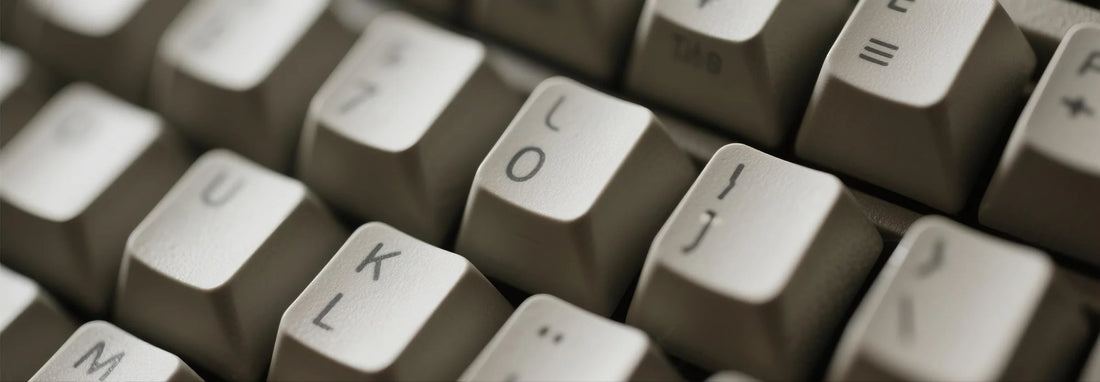
The Complete Guide to Cherry Profile Keycaps
HeJialeiShare
For mechanical keyboard enthusiasts, keycap profiles are more than just a style choice—they shape typing feel, ergonomics, and overall experience. Among the many options, Cherry profile keycaps stand out as a gold standard, prized for their balanced design, historical significance, and unmatched versatility. Let’s explore why they remain a favorite decades after their debut.
Origins and Design Philosophy
Cherry profile keycaps trace their roots to the 1980s, when they were introduced with Cherry’s iconic G80-3000 series keyboards (now part of ZF Friedrichshafen). What defines them is a sculpted, mid-height design where each row (labeled R1 to R4) features a unique angle and curvature, tailored to natural finger movement.
The R1 row (home to the Esc and function keys) is slightly taller with a steeper angle, while R2–R4 gradually shorten with gentler slopes, creating a tiered structure that guides fingers effortlessly across the keyboard. A rare R5 row, found on vintage models like the G80-1800, adds a steeper incline specifically for the spacebar row. Compared to taller SA profiles or flatter OEM designs, Cherry sits ~1–2mm lower, striking a perfect balance between responsive key travel and long-term comfort.
Material and Manufacturing: ABS vs. PBT
Cherry profile keycaps come in two primary materials, each catering to different preferences:
| Material | Pros | Cons | Common Uses |
| ABS | Smooth texture, vibrant color options, lower cost | Develops a glossy "shine" from oil buildup over time | GMK’s retro sets (e.g., Cherry 1953) |
| PBT | Durable, shine-resistant, matte grainy texture | Less vivid color range, higher price point | Keychron’s dye-sublimated themes (e.g., Brain Computer Interface) |
Premium sets often use doubleshot molding—injecting two layers of plastic to create legends (characters) that are part of the keycap itself, ensuring they never fade. PBT sets frequently employ dye-sublimation, a heat-transfer process that embeds ink into the plastic, ideal for intricate designs like sci-fi circuitry or retro synth art.
Compatibility: Layouts and Limitations
One of Cherry profile’s biggest strengths is its broad compatibility. These keycaps are designed for MX-style stems, fitting Cherry MX switches, as well as clones from Gateron, Kailh, and most other brands. They support a wide range of layouts: kits like Keychron’s 219-key set cover everything from compact 60% and 65% boards to full-size, HHKB, and UK ISO layouts, including specialized keys like split spacebars or stepped caps locks.
A notable caveat is north-facing RGB switches—on some boards, the keycap stems may block LED light, causing uneven backlighting (common with Cherry MX Reds, for example). For gaming-focused designs, Cherry’s PERFORMANCE KEY KIT for MX 5.0 keyboards reduces key travel for faster response but sacrifices cross-keyboard compatibility.
Why Choose Cherry Profile?
Cherry profile’s enduring popularity stems from its blend of function and flexibility. Ergonomics are a standout: the sculpted rows promote a natural wrist angle, minimizing fatigue during marathon typing sessions or gaming marathons. Aesthetically, they’re incredibly versatile—whether you prefer retro beige (like GMK 1953) or bold themes such as Keykobo’s chocolate-inspired ABS sets, there’s a design for every taste.
Typing feel varies by material: PBT’s grainy texture (like Keychron’s 1.5mm frosted finish) offers satisfying grip, while ABS provides a slicker, smoother glide. Beyond practicality, Cherry profile has deep community appeal—its heritage and customization potential make it a staple in group buys, DIY builds, and collector circles.
Practical Tips for Buyers
When shopping for Cherry profile keycaps, start by verifying layout coverage: ensure the kit includes the right spacebar size (6.25u vs. 7u), modifier keys, and novelties for your specific keyboard. For daily drivers, prioritize PBT for its durability and resistance to shine; ABS is better suited for collectors chasing vibrant, eye-catching colors. If you own a north-facing RGB board, test the fit first to avoid backlighting issues—some brands offer RGB-friendly stem designs to solve this.
The Future: Innovation Meets Tradition
While Cherry profile honors its legacy, modern sets continue to innovate. Keychron’s "Brain Computer Interface" caps blend taupe bases with retro accents, while synth-themed designs integrate faders and knob icons into key legends, merging nostalgia with creativity. Yet classics like GMK 1953 endure, proving that thoughtful, user-centric design never goes out of style.
Love mechanical keyboards? Share your favorite Cherry profile set with us!




